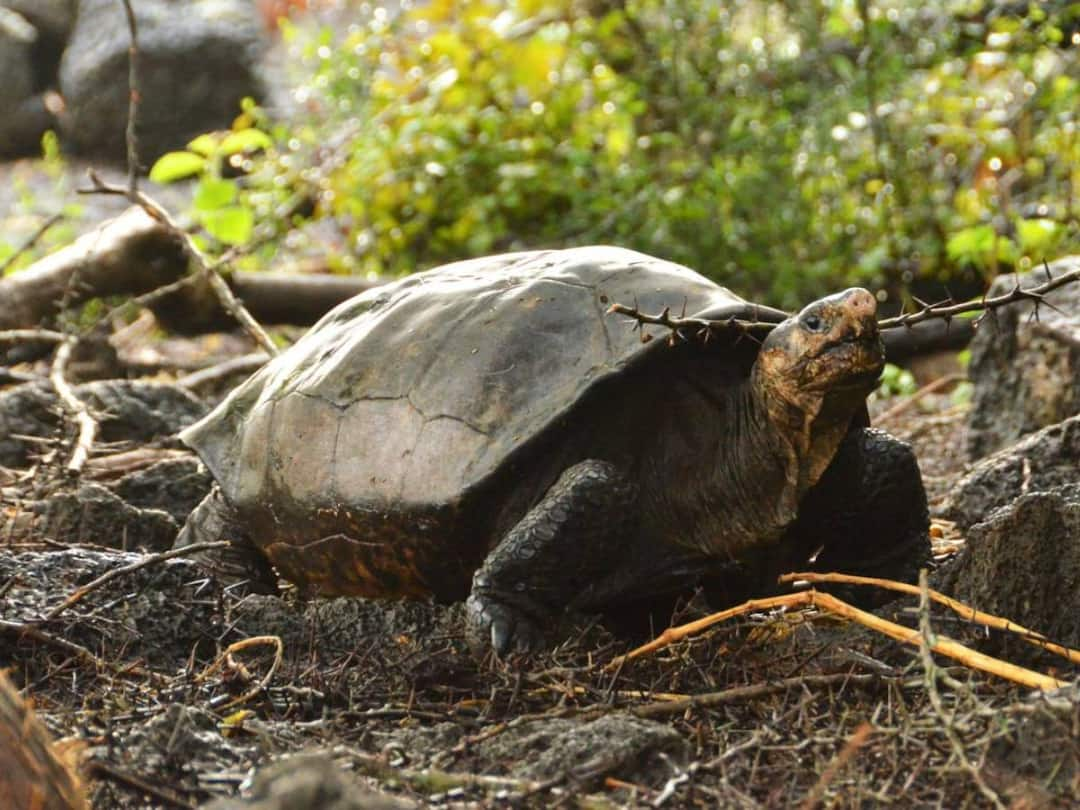Meet Fernanda: Believed Extinct For More Than A Century, Giant Tortoise Rediscovered In Galapagos
Fernanda is a Fernandina Island Galápagos giant tortoise & belongs to the species Chelonoidis phantasticus, which means "fantastic giant tortoise". It's known from a single specimen, collected in 1906

A fantastic giant tortoise that had long been believed extinct has been found alive on an island in Galápagos. The tortoise is named Fernanda after her Fernandina Island home. She is the first of her species identified in more than a century.
Fernanda is a Fernandina Island Galápagos giant tortoise, and belongs to the species Chelonoidis phantasticus, which means "fantastic giant tortoise". The species was known only from a single specimen, collected in 1906.
In 2019, a female tortoise was discovered living on Fernandina Island. This provided the opportunity to determine if the fantastic giant tortoise species lives on. A paper confirming the continued existence of the species was recently published in the journal Communications Biology.
Genome Of Fernanda Compared With Genomes Of 13 Species Of Galápagos Giant Tortoises
Princeton University's Stephen Gaughran, a co-first author on the paper, sequenced the genomes of both the living individual and the museum specimen of the species, and compared them to the other 13 species of Galápagos giant tortoises. He shows that the two known Fernandina tortoises are members of the same species, which is genetically distinct from all others.
In a statement released by Princeton University, Peter Grant, a professor on evolutionary biology at Princeton who has spent more than 40 years studying evolution in the Galápagos islands, said for many years, it was thought that the original specimen collected in 1906 had been transplanted to the island, as it was the only one of its kind, but it now seems to be one of a very few that were alive a century ago.
What Made Ecologists Doubt Fernanda Is Not A Native Phantasticus Tortoise?
Many ecologists doubted Fernanda to be a native phantasticus tortoise when she was discovered. Fernanda lacks the striking saddleback flaring of the male historical specimen, according to the study. Scientists speculated that Fernanda's obviously stunted growth may have distorted her features.
According to the statement, tortoises cannot swim from one island to another, but they do float, and can be carried from one Galápagos island to another during hurricanes or other major storms, and there are also historical records of seafarers moving the tortoises between islands.
Gaughran said that like many people, his initial suspicion was that this was not a native tortoise of Fernandina Island.
Gaughran sequenced Fernanda's complete genome and compared it to the genome he was able to recover from the specimen collected in 1906, in order to determine Fernanda's species definitively. The scientist also compared the two genomes to samples from the other 13 species of Galápagos tortoises, which include three individuals each of 12 living species, and one individual of the extinct Chelonoidis abingdonii.
Fernanda Was Very Similar To One Found More Than 100 Years Ago
Gaughran said the researchers involved in the study saw that Fernanda was very similar to the one that they found on that island more than 100 years ago, and both of those were very different from all of the other islands' tortoises.
Adalgisa Caccone from Yale University, a senior author on the paper, said the finding of one alive specimen gives hope and also opens up new questions, as many mysteries still remain. These questions include whether there are more tortoises on Fernandina that can be brought back into captivity to start a breeding program, how tortoises colonised Fernandina, and what their evolutionary relationship to other giant Galápagos tortoises is. Caccone said this also shows the importance of using museum collections to understand the past.
Though museum specimens are a challenge to analyse genetically, Gaughran has been focused on it for years, developing a tool that is flexible enough to work on many species, and compare DNA from ancient specimens to modern specimens. He said the software does not care if it is a seal or tortoise or human or Neanderthal, and that genetics is genetics, for the most part. It is in the kind of interpretation where it matters what kind of the creature the DNA comes from, he explained.
Andrea Graham, an ecologist at Princeton, said Stephen Gaughran solves conservation mysteries, in species ranging from tortoises to pinnipeds, with the deft and careful application of genetic and bioinformatic tools. Bridgett vonHoldt, another ecologist at Princeton, said Stephen has such a curiosity for discovering the messages and codes tucked away in ancient remains. He added that Stephen has been collecting specimens from several hundred years old to a few thousand, and these really hold the keys for understanding the history of when and how genomes changed over time. Bridgett vonHoldt asserted that it is not surprising to him that Stephen also led the effort to unravel the mystery of Fernanda, the fantastic ghost tortoise that has been rediscovered through molecular research.
Compelling Evidence On Existence Of Giant Tortoises On Fernandina Island Since 1906
Since 1906, there has been scant but compelling evidence which hinted that giant tortoises might still live on Fernandina Island, an active volcano on the western edge of the Galápagos Archipelago that is reputed to be the largest pristine island on Earth, the study said.
Explorer Rollo Beck Collected Single Specimen Of C. phantasticus In 1906
According to the statement, a single specimen of Chelonoidis phantasticus, "the fantastic giant tortoise", was collected by explorer Rollo Beck during a 1906 expedition. The study said that the "fantastic" nature refers to the extraordinary shape of the males' shells, which have extreme flaring along the outer edge and conspicuous saddlebacking at the front, a feature unique to Galápagos tortoises. The phantasticus tortoise shows saddlebacking more prominently than the other species.
Other Observations Of Tortoises On Fernandina Island
Ever since the Fernandina tortoise was discovered in 1906, its survival has remained an open question for biologists. As many as 18 scats attributable to tortoises were reported on the western slopes of Fernandina Island, in 1964. During the early 2000s, scats and a possible visual observation from an aircraft were reported. In 2014, another tortoise scat was seen.
Due to the extensive lava fields blocking access to the island's interior, the island has remained largely unexplored.
Fernandina Island Is Highest Of Galápagos Islands
Grant said Fernandina is the highest of the Galápagos islands, geologically young, and is mainly a huge pile of jagged blocks of brown lava. He added that at lower elevations, the vegetation occurs in island-like clumps in a sea of recently congealed lava, and that Fernanda was found in one of these. There is evidence that a few relatives may exist in others, according to Grant.
Fernanda is estimated to be well over 50 years old. However, she is small, possibly because of the limited vegetation, the study said. During other recent expeditions on the island, the researchers found recent tracks and scat of at least two or three other tortoises.
Storms Carried One Or More Giant Tortoises
About two to three million years ago, one or more giant tortoises were carried from the South American mainland westwards due to storms. The tortoises are only with others on their own islands because they do not swim. This resulted in rapid evolution, following the pattern of the better-known Galápagos finches. At present, there are 14 different species of giant Galápagos tortoises all descended from a single ancestor, according to Princeton University.
Though some scientists debate whether these tortoises should be considered species or subspecies, the Princeton-Yale team concluded that they are different enough, with thousands of distinctive genetic markers, to be considered separate species.
How Galápagos Tortoises Diversified
As the Galápagos tortoises diversified, they developed a continuum of shell shapes, with the easternmost islands' animals showing rounder, domed shells, and the westernmost island — Fernandina — home to tortoises with the most dramatic saddlebacking.
While the domed tortoises live in more humid, higher elevation ecosystems, their saddlebacked cousins inhabit drier, lower elevation environments. All the 14 species of giant Galápagos tortoises are listed on the International Union for Conservation of Nature's (IUCN) Red List as either vulnerable, endangered, critically endangered or extinct.
How The Tortoise Populations Decimated
European seafarers hunted the tortoise populations for food, resulting in the decimation of their populations. The tortoises were used as food because the seafarers realised that the animals could be alive on ships with minimal effort, and could survive with little food or water. Gaughran said they were a great source of fresh meat for the sailors, but it meant that many of the species were severely overhunted.
Where Are Nearest Relatives Of Fernandina Tortoise Found?
Grant added that the genetic work provides intriguing hints of a mixing of genes with members of another population, and that it would be fascinating if confirmed by future detective work on the genome. The researchers also found that the nearest relatives are not on the nearest very large island, Isabela, but on another island, Española, which is far away on the other side of Isabela. The question of how the ancestors reached Fernandina is left hanging, Grant said.
According to Princeton University, Fernanda is now at the Galápagos National Park Tortoise Center, a rescue and breeding facility, where experts are seeing what they can do to keep her species alive.
Grant said the discovery informs researchers about rare species that may persist in isolated places for a long time, and this information is important for conservation. He added that it spurs biologists to search harder for the last few individuals of a population to bring them back from the brink of extinction.
Related Video
Southern Rising Summit 2024: How Important is Self-Awareness? Insights from Anu Aacharya | ABP LIVE






































